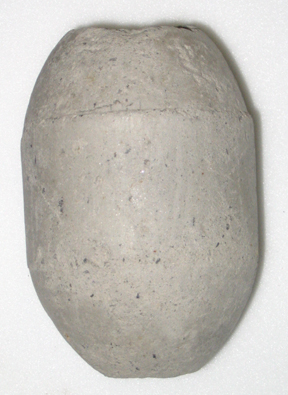This is a training grenade similar in shape to the
No. 36M Mk I grenade. It is
designed to simulate the action of a bursting grenade.
Introduced on 6 July 1942.
The body is basically oval in shape with some
having sixteen longitudinal grooves on the straight sides of the body to
provide a firm gripping surface.
The body, made of clay, is drilled from the top to within ½ inch
of the bottom. The bursting
charge consists of a rolled paper sleeve filled with 11.5 grams of G12
gunpowder. The ends of the
tube are closed by cork discs.
The charge is ignited by a 2 inch length of No. 11 Mk. 2 safety
fuze that passes through the cork disc into the main charge.
A steel or copper ferrule is crimped onto the exposed end of the
fuze with the open end filled with match head composition.
The burster is waxed and the exterior of the fuze shellac
varnished for waterproofing.
Once the burster is inserted into the grenade body the open top
is filled with bitumen.
The body is painted white with a ¼ inch red filling
ring around the top.
For use, the match head is struck with a brassard
and the grenade immediately thrown.
The match head ignites the fuze that burns for 5 seconds.
After the delay the fuze flashes from the bottom end into the
gunpowder which then ignites.
The grenade gives a sharp bang and puff of smoke.
A reasonable safety distance must be maintained due to the danger
of lumps of clay being projected.
